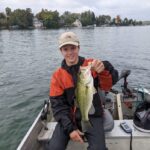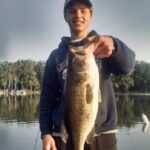Hey there anglers! When it comes to bass fishing, the bass jig may be one of the most versatile lures in your tackle box. The jig works throughout all seasons and can be fished through a variety of cover. If you’re ready to up your bass fishing game, you’re in the right place. Today, we’re diving into the world of jig fishing for bass. Whether you’re a seasoned pro or just starting out, this guide will provide you everything you need to know about how to fish a bass jig. Lets get started!
Table of Contents:
What Is a Bass Jig?
Before we dive into the nitty-gritty, let’s break down the basics. What exactly is a jig? A bass jig has a tungsten or lead weighted jig, a weedguard, and a skirt. Bass jigs comes in a variety of different jig head styles and sizes that cover a broad range of scenarios you may encounter on the water. The main two types of forage that they imitate are crawfish and baitfish.
Why Jigs are Effective for Bass
Jigs are effective for bass since they can be fished pretty much anywhere a bass swims. Additionally, you can tailor your presentation to match exactly what the bass are feeding on at a given time. For example, if your bass are feeding on crawfish, hop a jig on the bottom. If your bass are feeding on bluegill, swim a jig mid-column. The opportunities are endless.
The Main Types Of Bass Jigs
Picking the right jig can be a bit overwhelming, but fear not! Let’s break it down by the main types of bass jigs currently available.
Casting Jigs
As the name implies, casting jigs are meant for casting. These bass jigs typically have an arky style of jighead with a medium size weedguard and hook. If you could only choose one bass jig, this would be my recommendation. The way I think about a casting jig is that you can get away with fishing it pretty much anywhere. It may not be the best option, but it will get the job done.
Main Retrieves: Dragging, Hopping
Football Jigs
The name of this bass jig comes from the shape of the jig head, which is reminiscent of a football. Football jigs are ideal for fishing on the bottom in gravel, mud, or rocks. The shape of this jig head prevents it from getting snagged in rock cervices and keeps the lure balanced in the water. If you plan on fishing in weeds, this is NOT the bass jig for you. Cast a football jig out, let it go to bottom, and slowly drag it in.
Main Retrieves: Dragging, Stroking
Flipping Jigs
Flipping jigs are designed for heavy cover applications. These jigs have a pointed jig head, heavy weedguard, and heavy wire hook. Flip this jig in an around thick grass, submerged timber, dock pilings, and any other cover where bass may be hiding. Make sure to use a heavy power rod and heavy line when fishing with this style of jig.
Main Retrieves: Flipping
Finesse Jigs
Finesse jigs are bass jigs that have a smaller profile and downsized components. This style of jig typically has a ball-shaped jig head, light weedguard, and a lighter wire hook. The advantage to finesse jigs is that you can get away with fishing lighter line to fool finicky fish. Additionally, if the bass in your lake are on the smaller size or simply used to seeing full-sized jigs, a finesse jig can help you get a few more bites. Finesse jigs work best in sparse cover and are not meant for heavy cover applications.
Main Retrieves: Dragging, Hopping
Swim Jigs
Swim jigs are unique in the fact that they are meant to be fished mid-column. This style of jig typically has a pointed jig head, medium or light weedguard, and lighter wire hook. The shape of the jig head allows this lure to cut through vegetation and without getting hung up while remaining balanced through the water. The trailer is a critical component for the action of your swim jig. Choose a trailer that has lots of action through the water. The key is that you want the trailer to make your jig pulse through the water and impart action to the skirt material.
Main Retrieves: Swimming

Jig Trailers
There are countless bass jig trailers on the market, but we’ll simplify them into two main categories; Action and Minimal Action. Choose the style of jig trailer based on the type of forage you are imitating. For example, use a craw-style trailer to imitate crawfish and a paddle tail trailer to imitate baitfish.
Lots of Action
These are your jig trailers that have all sorts of appendages which create movement and vibration through the water. Choose a jig trailer with lots of action when the water temperature is warmer and fish are aggressive. Additionally, these styles of jig trailers work great for open-water scenarios since they help impart action to the jig skirt.
Minimal Action
These are your jig trailers that don’t have many appendages are are more streamline through the water. Choose jig trailers with minimal action when the water temperature is cool and fish are lethargic. Additionally, these styles of jig trailers work great when fishing flipping jigs in heavy cover. Too many appendages can get caught up in weeds and hamper your ability to fish effectively.
Matching the Jig to the Conditions
Remember, each lake is different. Make sure to pay attention to the conditions you are faced with and adjust your bass jig accordingly.
Jig Weight and Size
It’s all about balance here. The jig’s weight affects its sink rate and how deep you can effectively fish it. Deeper waters call for heavier jigs, while lighter jigs are ideal for shallower areas. Also, consider water temperature. For warmer water I tend to opt for a heavier jig while colder water calls for the lightest jig you can get away with. This is because the baitfish and crawfish move much quicker and are more active in warmer water compared to cold water.
Jig Color
The water clarity, depth, and cover play a crucial role in your jig choice. If the water’s clear as crystal, go for more natural colors and match the hatch. When it’s murkier, opt for bold colors that stand out. Solid skirt colors stand out much better when fishing dirty water compared to color patterns that have several different colors throughout.
Jig Modifications
Remember, you’re the master of this jig. Modify its action and appearance by trimming the skirt or adjusting the trailer. Additionally, consider tying your own bass jig to have full control.
How To Fish a Bass Jig
Now that you’ve got your jig sorted, let’s get into the fun part – how to actually fish it!
Dragging
Dragging a jig refers to slowly pulling your jig along the bottom. This can be done using your rod tip or by slowly turning your reel handle. The key to this retrieve is maintaining bottom contact and crawling the bass jig slowly. Don’t be afraid to occasionally pause your jig as well, especially when you feel it come up against a large rock or other piece of cover. Use this retrieve when fishing sand, gravel, rocks, mud, or other bottom types with minimal hang ups.
Flipping or Pitching
Flipping or pitching a jig refers to making short underhand casts directly to visible cover. This can be docks, weed clumps, submerged timber, or any other cover where bass may be holding. A heavy power rod and heavy line is necessary to set the hook and pull bass out of the cover.
Stroking
Stroking a jig refers to aggressively snapping a jig several feet off bottom and then letting it fall on slack line. Most of your strikes will occur when the jig is falling. This retrieve is typically used for offshore bass in the summer. Consider stroking a jig when bass are schooled up and you need to trigger a feeding response. Additionally, this retrieve is a good option if the fish are suspended several feet off of bottom.
Hopping
Hopping a jig refers to hopping your jig within a few feet of the bottom. Typically, it is either a single-hop or double-hop before letting the bait fall back to the bottom. Think crawfish imitation with this retrieve. Don’t be afraid to pause the jig in between hops.
Swimming
Swimming a jig refers to reeling it in mid-column. This is a great retrieve to use when imitating baitfish. Simply cast the jig out, let it sink to the desired depth, and reel it in at a constant speed. If you have the correct trailer, the trailer will impart all of the action for you. Don’t be afraid to through your jig in and around cover and let it deflect off of it when swimming a jig. This change in direction can trigger bites a lot of the time.
And there you have it, – everything you need to know about fishing bass jigs! Remember, be willing to step out of your comfort zone and try new things. Mix up jig styles, colors, and retrieves. Sometimes, what works one day may not necessarily work the next. So put your newfound knowledge to the test the next time you are out on the water. Tight Lines!
More Bass Fishing Articles:






